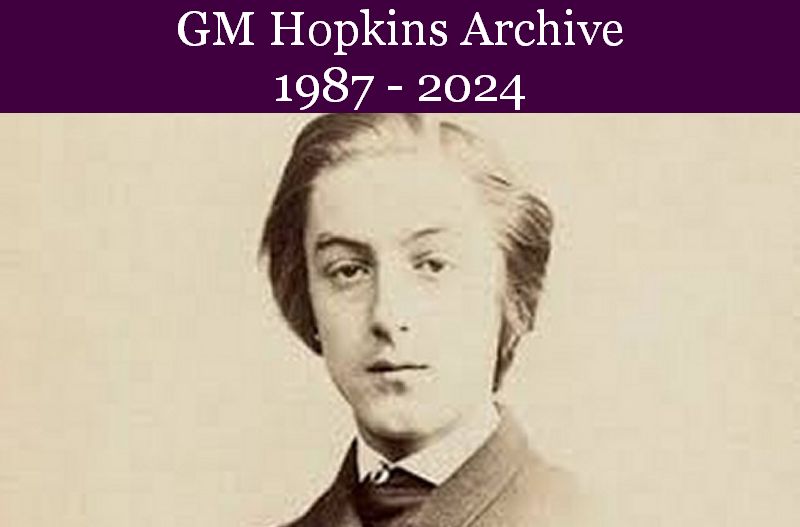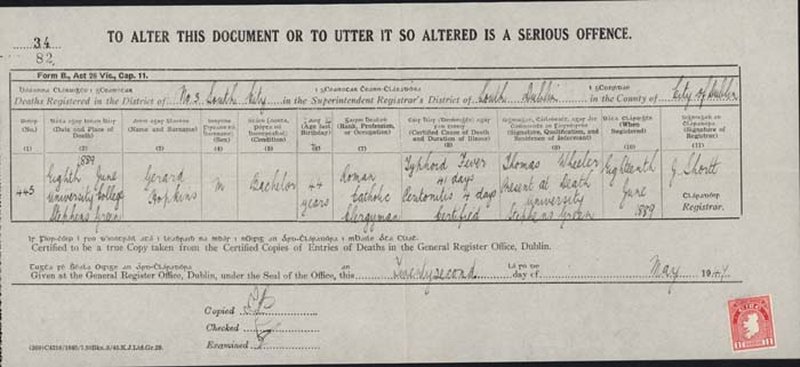Links to Hopkins Literary Festival 2007
The Gerard Manley Hopkins Archive, a free resource for everybody, contains lectures on: Hopkins and Newman; the Church in the juvenile poems of Gerard Manley Hopkins; Gerard Manley Hopkins, Aubrey DeVere, and Considerations on New Historicism; Gerard Manley Hopkins's Misdirected Faith; On the Road with Gerard Manley Hopkins.
Hopkins and Newman
Ian Ker,
Oxford University.
While Newman was on holiday in Switzerland during August and early September 1866, the young undergraduate Hopkins wrote hesitantly to him at the Birmingham Oratory on August 28, asking if he might intrude on the great man, rightly assuming that he was very busy and that he was 'much exposed to applications from all sides'. (1) What Hopkins did not know was that less than a month before while visiting Glion Newman had at last realized where he must begin the argument of what was to become his philosophical magnum opus, An Essay in Aid of a Grammar of Assent (1870) ...
Read the full text of the Ian Ker Lecture, Hopkins and Newman, here
'Where Springs not fail' Church in the juvenile poems of Gerard Manley Hopkins
Dr hab. Aleksandra Kedzierska,
Instytut Anglistyki,
Lublin,
Poland.
Although much - and from different angles - has been written about G.M. Hopkins's priesthood, far too little attention has been paid to the depiction of the Church he strove to build also in his poems. Despite the many building blocks he left for the critics to work with, he still has no church he could truly belong to, and failed thus even by his poetic heaven-haven, he is still exposed to the fate of the 'fortune's football'. Hence, in an attempt to make up for this rather disrespectful gap in Hopkins's scholarship, and, simultaneously, to put an end to the paradoxical homelessness of the priest poet, this essay will concern itself with reconstructing, from the textual evidence available, the image of the church he evoked in his poems. As, however, the is a very complex topic, it is my intention to focus on the least known of Hopkins's works, his juvenilia. . .
Dr. Kedzierska's lecture on the Church on Hopkins ' Juvenile Poetry
Hopkins, Aubrey DeVereand and Considerations on New Historicism
Patrick Samway, SJ,
St. Joseph's College,
Philadelphia,
USA
I have it on good authority from someone I live with in Philadelphia that Hopkins enjoyed both the language of play and the play of language. The linguistic arabesques and interlocking configuration of images in "Dun's Scotus's Oxford" - such as "Cuckoo-echoing, bell-swarmed, lark-charmèd, rook-rackèd, river-rounded"- are, to cite but one example of such language, traps for poetic meditation. Who among us can easily but his or her arms around this language, to find epistemological connections that are grounded metaphysically in things as they are or things as we know them? . . .
Patrick Samway's lecture, Hopkins and Newman, here
Gerard Manley Hopkins's Misdirected Faith
David Axelrod,
Poet and Writer,
New York,
USA.
Viewed from the perspective of a non-believer, Gerard Manley Hopkins's unfortunate religious obsession seems responsible for the suppression of one of literary history's great poetic talents and as likely for his early death. That Hopkins is best known and most frequently anthologized for religious poems like "Pied Beauty," is an unfortunate irony, for it is as likely that his true religion and greatest gift-poetry itself-was seriously damaged and at times completely suppressed by his misdirected zeal for God . . .
David Axelrod's lecture, an unbelever's view of Hopkins's Misdirected Faith
Axelrod's 2008 Lecture, A Quantum Electrondynamic Interpretation of Hopkins Poetry
"Lightness": A New Perspective on Hopkins
Joseph J. Feeney, S.J.,
St. Joseph's University,
Philadelphia, USA
Hopkins is famously known as a difficult poet, even a "heavy" poet, and in truth, he is heavy in content, heavy in style, and heavy in sound. The scholar James Milroy, in his book The Language of Gerard Manley Hopkins , notes the poet's "dense verbal structure," and in print I've called his texture "granitic" and his density "hard as granite." Today, by way of contrast, I consider a different side of Hopkins, a side much less noticed: his "lightness." I offer my comments in three parts: (I) confirming Hopkins' heaviness, (II) defining "lightness," and (III) establishing Hopkins' lightness . . .
Father Feeney SJ's Lecture Lightness, a New Perspective on Hopkins
Elizabeth Bishop and Gerard Manley Hopkins
Ben Howard,
Professor of English Emeritus,
Alfred University,
New York,USA
In his sonnet "Duns Scotus's Oxford," Gerard Manley Hopkins pays tribute to a kindred spirit. Contrasting the "graceless growth" of Victorian Oxford with the "grey beauty" of the older buildings, he invokes the memory of the medieval theologian Duns Scotus, the "rarest-veined unraveller," who lectured at Oxford in the early fourteenth century. "[T]hese walls are what / He haunted," Hopkins recalls, "who of all men most sways my spirits to peace." (1) Balancing the past and present tenses, these lines portray Duns Scotus as both a historical figure and a timeless, countervailing presence in the poet's life and art. Something similar might be said of Hopkins's own presence in the life and art of the American poet Elizabeth Bishop (1911-1979), who discovered Hopkins at the age of thirteen, when she read his poems in Harriet Monroe's anthology of modern poets.
Howard on Hopkins and Elizabeth Bishop
Patrick Kavanagh and Hopkins: A Strange Combination
Una Agnew, SSL,,
Milltown Institute,
Dublin.
While Gerard Manley Hopkins was a classical scholar, Oxford Don, well versed in the aesthetics of Ruskin and the philosopy of Duns Scotus, Patrick Kavanagh, on the other hand, a poor farmer, had probably never heard of either. He completed his formal education at 14 years of age; school records indicate that he has not been promoted into Sixth Class.
Yet, they both Kavanagh and Hopkins found God compellingly present in the created universe.
To argue any strong resemblance in background, temperament and upbringing of the distinguished Oxford Don, Gerard Manley Hopkins and the socially inept, self-educated farmer-poet Patrick Kavanagh, must surely appear ludicrous. Hopkins was born into a Victorian upper middle-class family in Stratford in 1844, got the best English public-school education available, while Kavanagh, the son of a cobbler was born sixty years later in the townland of Mucker, Inniskeen, Co Monaghan and did not progress beyond fifth standard in the small, rural, two-teacher, at Kednaminsha.
Patrick Kavanagh and Hopkins found God compellingly present ...
The Breastplate of Saint Patrick and Hopkins
Sean Bagnal,
President GM Hopkins Society 2o22,
Naas, Co. Kildare.
Some years ago during the Hopkins Festival, Ernest Ferlita, SJ , described Hopkins' love of Saint Patrick's Breastplate. He also spoke of Hopkins intention to publish a new critical edition of Saint Patrick's Confession
. Hopkins was aware of and interested in these documents before he ever came to Ireland. Were there Christians in Ireland before Saint Patrick's arrival?
Most of us think immediately of the coming of Patrick in 432AD. But we fail to think of the
possibility of Christianity and Christians having Ireland before Patrick's arrival. This is relevant because there is some evidence of Christian communities and we can speculate about such communities in here in the East of the Country before Patrick came to Ireland. We will look at this question from several directions. Sean Bagnall examines the writings of St Patrick, including the Breastplate.
Saint Patrick's Writings including his Breastplate
Sister Jeanne Crapo O.P,
Dominican University,,
River Forest,
Illinois, USA.
Margaret Johnson in her essay, "These Things were There," says of Hopkins' poetry, "How can I deal with poetry that sees, even in apparent absence, the perpetual presence of God" (71). How indeed! It is a challenge.
In the "Wreck of the Deutschland" the first poem after the seven year silence, the poet tells of God's ways with him and then turns to the story of the sinking ship itself In the picture of tempest and terror, he tells of the tall nun standing on the deck and crying "Christ, Christ come quickly!" He is moved by her courage and her eagerness to meet Christ ...
Links to Hopkins Literary Festival 2007
Faather Hopkins SJ on Retreat
Elizabeth Bishop and Hopkins Poetry
Aubrey de Vere and Gerard Manley Hopkins
Patrick Kavanagh and Gerard Manley Hopkins
Communion of Saints in Hopkins Poetry
Saint Patricks Breastplate
Place of Church in Hopkins Juvenile Poems
Cardinal Newman and GM Hopkins
Hopkins Misdirected Faith
Father Hopkins SJ the Priest
Lectures from GM HOPKINS FESTIVAL 2023

